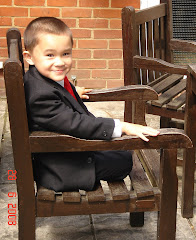Out of curiosity, I googled Apraxia misdiagnosed Autism. Here is an interesting article:
What is the Difference Between Apraxia and Autism?
Posted in Health & Fitness on May 5th, 2008Apraxia and autism are two entirely different neurological disorders which can occur in a child independently of one another, or together in the same child. While autism’s symptoms can impact and impair many different systems, behaviors, and thought patterns, apraxia occurs when the child struggles to plan and carry out voluntary physical movements.
In terms of gross motor skills, apraxia may impact a child’s capabilities to stand up, sit in a chair, or catch a ball and with fine motor skills, a child may not be able to zip up a jacket, button a shirt, write or print, or even point at an object.
Children with apraxia may also struggle to produce sound patterns to make words, or even coordinate the various speech mechanisms to make the individual speech sounds such as the difference between a “g” and a “b” sound, or the hum of an “m” sound. Even when a sound is modeled, a child with apraxia may not be able to mimic the same sound.
However, though these symptoms may also cross over into autism, there remain important differences between the two conditions. For example, when a child has only apraxia it is only the motor functioning and not the social and emotional skills that are impacted, as is often not the case with autism.
Apraxia and autism can become difficult to tell from one another when the child is exhibiting symptoms of verbal apraxia (officially known as oral-motor apraxia). The reason for this is that children with either condition can be very aware of their struggle to communicate verbally, and therefore they may choose to avoid having to talk by staying away from social situations. However, in the case of verbal apraxia, if you play with your child and don’t demand speech from him or her, you may find that they begin playing actively and engage others in their play.
The child usually experiences relief from being able to socialize and have contact with others without being required to talk, which is frustrating for them and can create a fear of failure. Often, with these children, when they are allowed to select the type of play and are allowed to go without having to speak, the relief and comfort they feel can make them more open to accepting the slow introduction of new sounds and syllables, which may eventually bring about simple words into their favorite games and play. Encouragement to vocalize or verbalize should be gentle in both apraxia and autism, and should be gradual, tailored to the pace of success rather than to a schedule.
In both motor apraxia and autism, children show social interaction problems, but in the case of motor apraxia, this is normally because they are not always capable of performing the physical movements that allows them access to others. However, motor apraxia won’t usually make a child want to avoid social interaction altogether, such as failing to make eye contact, or specifically moving away from other people.
It is easy to see why there is so much confusion between apraxia and autism spectrum disorders. Especially considering children with these conditions can also both exhibit signs of over-reactivity to sensations. However, there are differences between the two and it is important to speak to your doctor or a specialist if you are unsure. Your doctor will be able to determine which condition your child may have, or if both are present.
Grab your free copy of Rachel Evans’ brand new Autism Newsletter - Overflowing with easy to implement methods to help you and your family find out about apraxia and autism and for information on levels of autismplease visit The Essential Guide To Autism.


No comments:
Post a Comment